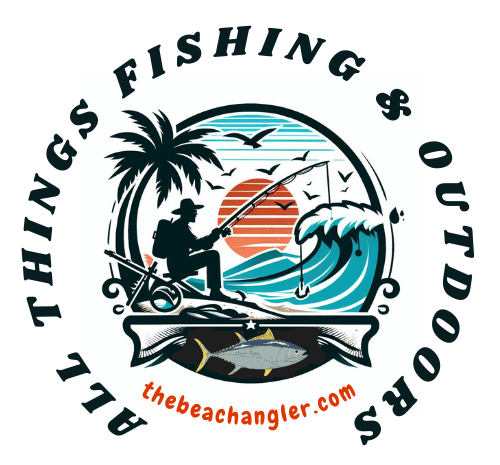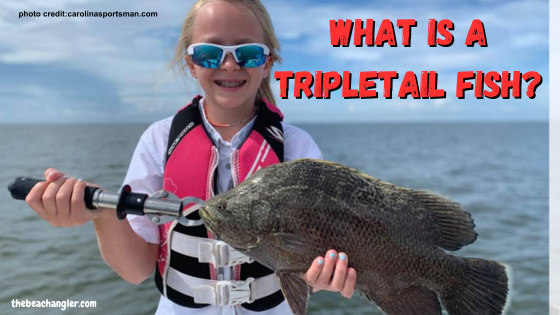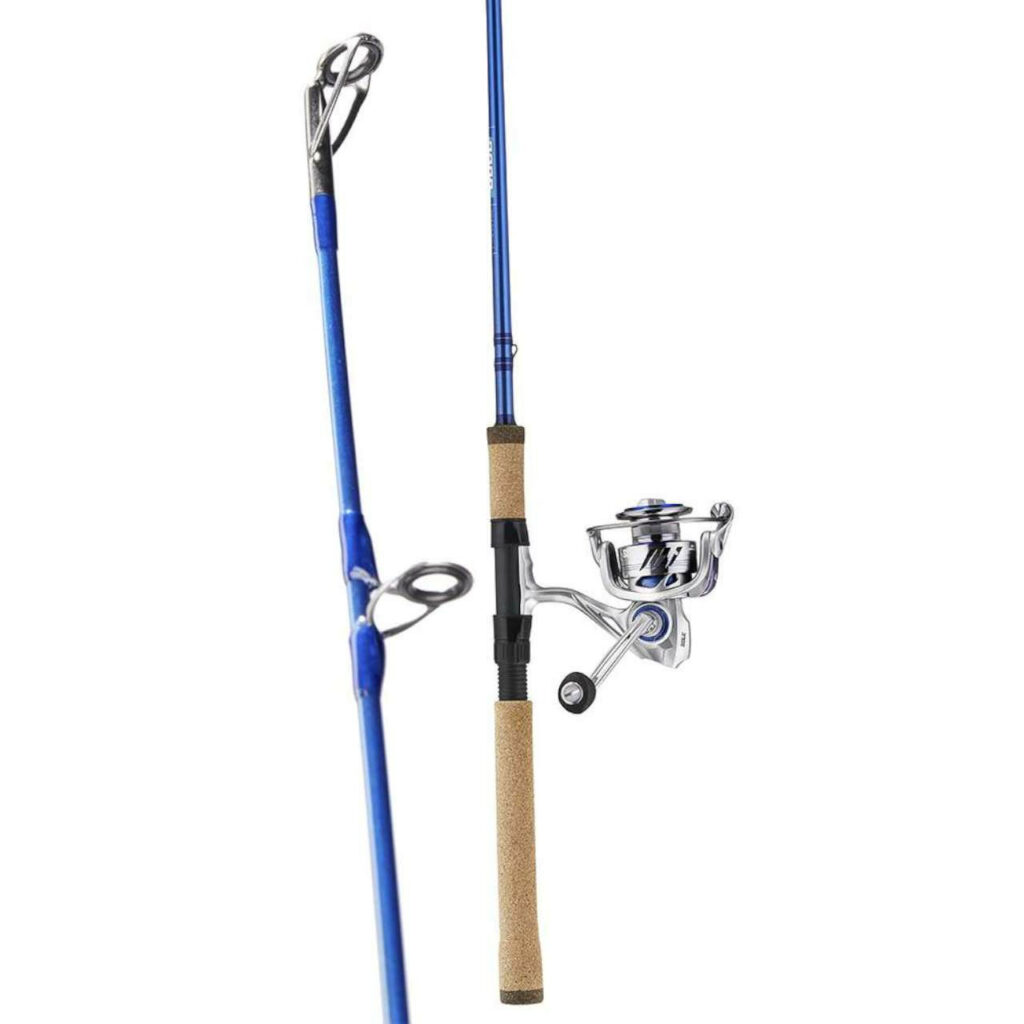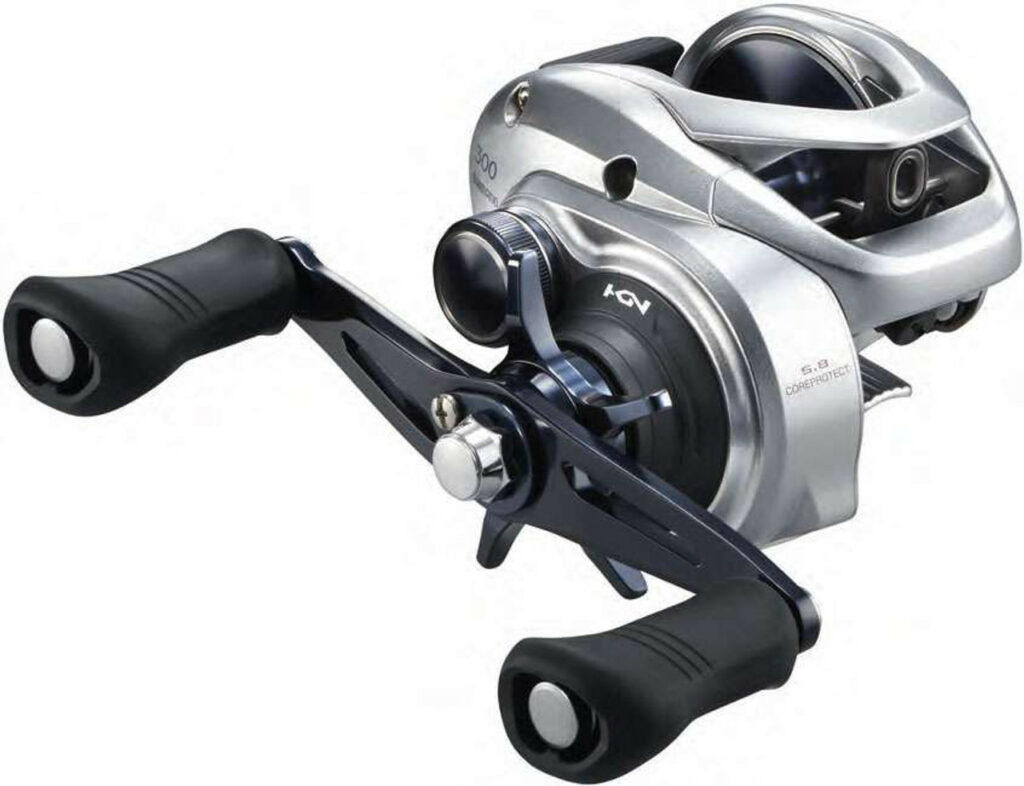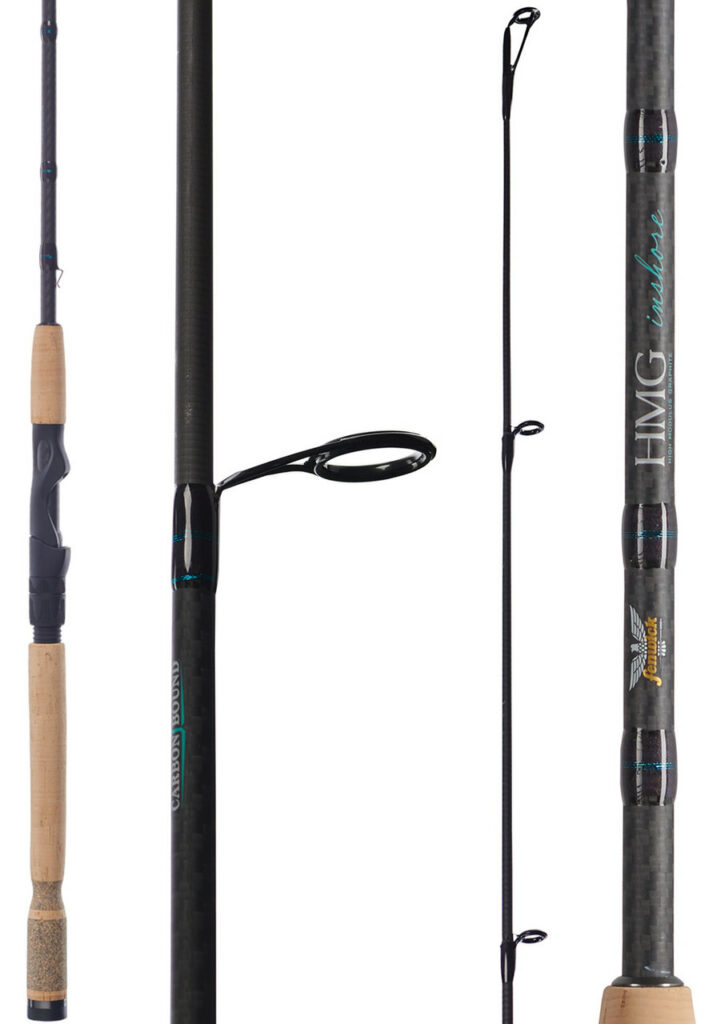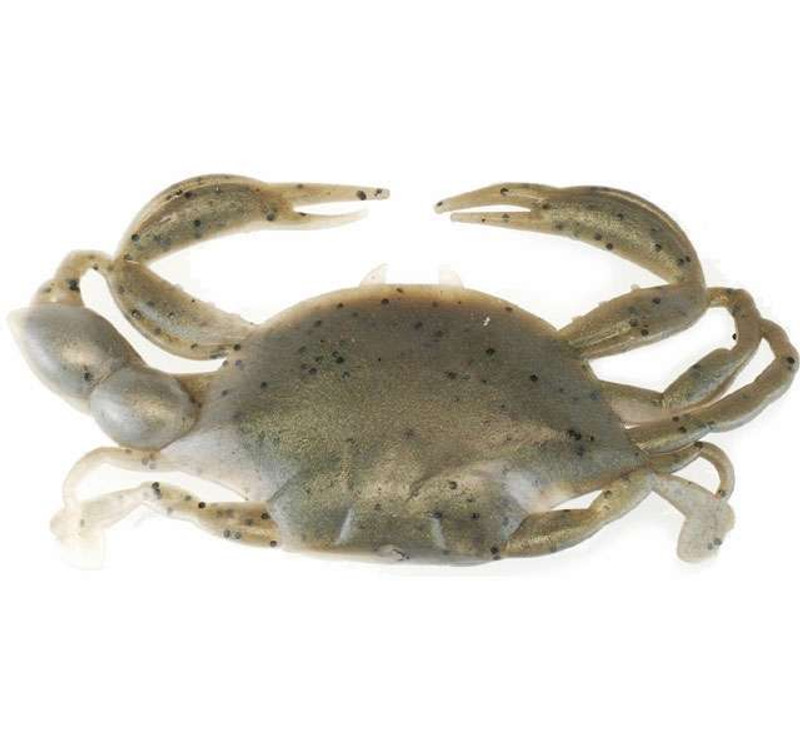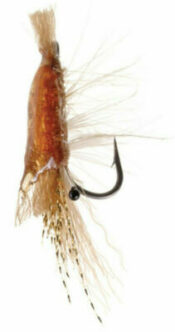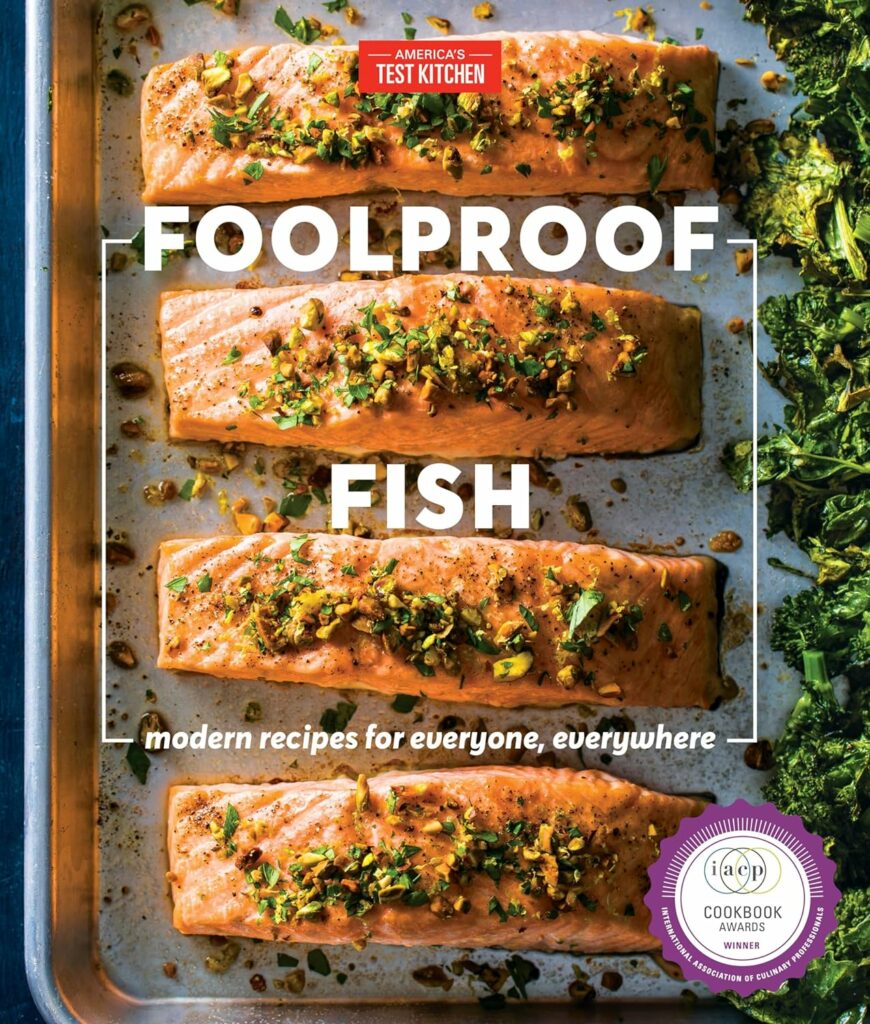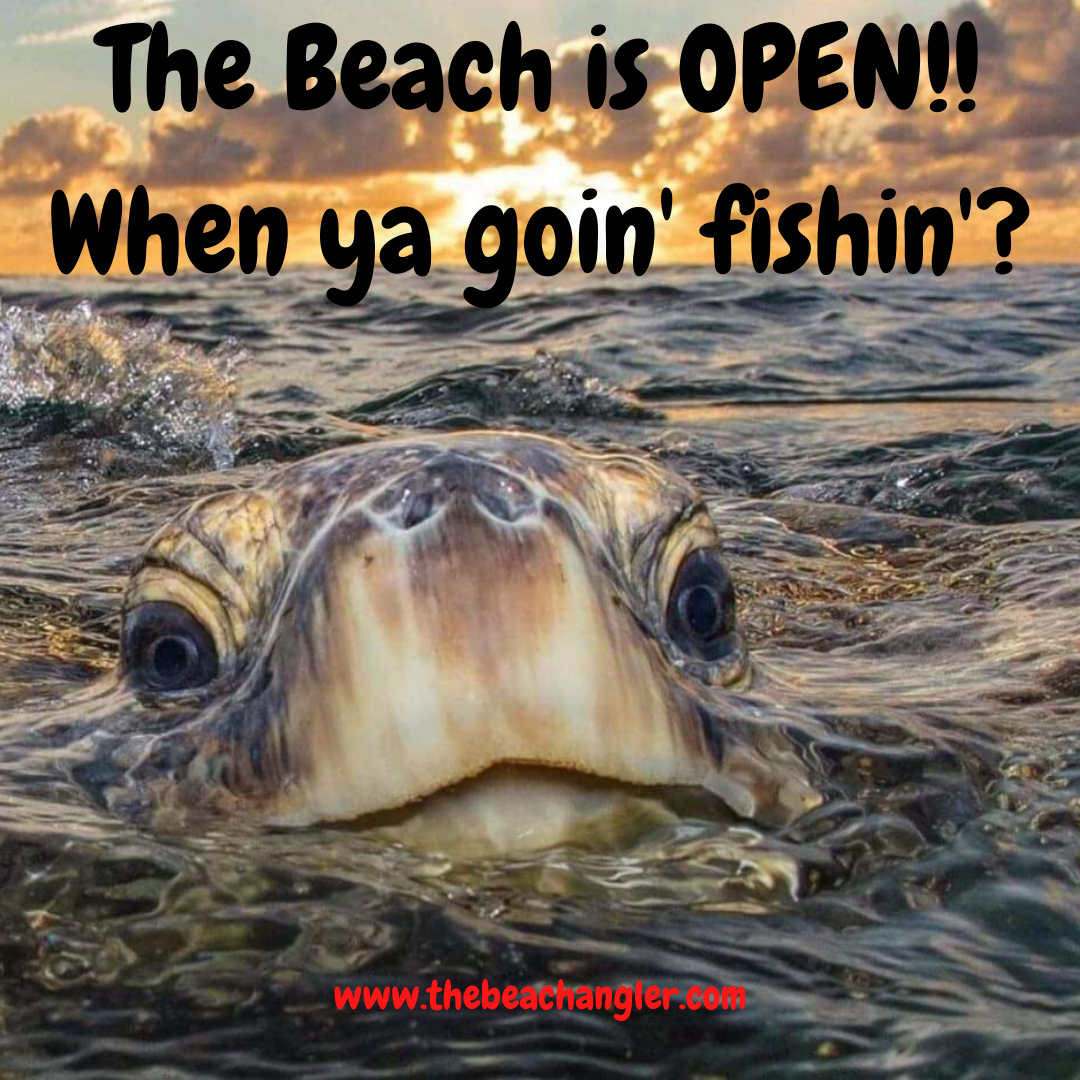If you’re a serious saltwater angler, you might have heard of the tripletail fish. This fish is one of the most interesting and delicious fish you can catch in the Gulf of Mexico and other tropical waters. But what is a tripletail fish exactly? And how can you catch and cook it? Read on and we’ll answer these questions and more as we learn more about this amazing fish.
QUICK LOOK:
- 1. Spotting Tripletail – Look for floating structures, debris, or buoys where Tripletail may seek shelter.
- 2. Approaching Stealthily – Tripletail can be easily spooked, so approach your target area quietly and avoid making unnecessary noise.
- 3. Accurate Casting – Cast your bait or lure with precision, placing it close to the Tripletail’s suspected location.
- 4. Practice Patience – Tripletail may take their time inspecting the bait before striking, so exercise patience during the waiting game.
- 5. Delayed Hookset – When you feel a bite, resist the urge to set the hook immediately.
- 6. Maintain Steady Pressure – Once the hook is set, maintain tension on the line to prevent the fish from shaking the hook.
- 7. Landing Tripletail – Use a landing net or fish gripper to secure the Tripletail, avoiding direct contact.
Now, tripletail are obviously not one of the more well-known gamefish species. In fact, you may have never heard of them much less ever even seen one. They haven’t been studied much until recently so little is known of their life cycle and habits. But, if you do get a chance to fish for them, they put up a great fight and they make excellent table fare. But what is a Triple tail fish exactly?
What is a Tripletail Fish?
Tripletail fish, scientifically known as Lobotes surinamensis, are a fascinating species that lure anglers with their distinctive appearance and thrilling catch. Found in warm coastal waters, these fish are known for their unique features and challenging behavior, making them a prized target for fishing enthusiasts.
Tripletail fish are easily recognizable by their triangular dorsal fins and rounded anal fins, which give them a distinctive appearance resembling a large freshwater sunfish. Their bodies are flattened, and their coloration can range from dark brown to olive green, providing effective camouflage in their natural habitat.
These elusive creatures are predominantly found in the Atlantic, Indian, and Pacific Oceans, favoring the warm waters of bays, estuaries, and nearshore environments. Tripletail are known to inhabit areas with floating debris, such as seaweed, where they can ambush prey and evade predators.
Tripletail fish feeds on crustaceans, mollusks, small fish, and insects. It is active during the day and rests at night. They migrate seasonally to find suitable water temperatures and food sources. Tripletail spawn in offshore waters from spring to fall
What Does a Tripletail Fish Look Like?
Tripletail fish gets its name from its unique appearance. It has a deep body and rounded fins that look like three tails. The dorsal and anal fins extend beyond the caudal peduncle, creating the illusion of three symmetrical caudal fins. The caudal fin itself is rounded and has a yellow margin.
Tripletail fish can grow up to 90 cm or 36 inches long and weigh 18 kg or about 40 lbs, but most of them are around 80 cm or 30 inches and 10 kg or 22 lbs. The color of the tripletail fish varies depending on its habitat and age. It can be brown, black, gray, or yellowish, with dark spots and blotches. The young ones have white pectoral fins with black edges.
That is one of the remarkable features of Tripletail, their ability to change color to match their surroundings, a trait that adds to their mystique. This adaptive camouflage not only aids in hunting but also serves as a defense mechanism against larger predators.

Perhaps the most characteristic, certainly one of the most unusual, is the habit of lying just below the surface, floating with one side exposed, looking like floating debris. Large adults are sometimes found near the surface over deep, open water, although always associated with floating objects. Young fishes are also often found in or near shipwrecks, beams or supports, jetties, flotsam and sea buoys.
Fishing for Tripletail, What to Look for:
Tripletail fish are not very common, but they are very distinctive. Here are some tips on how to identify a tripletail fish in the water:
- Look for a fish that has a deep body and rounded fins that look like three tails. The dorsal and anal fins extend beyond the caudal peduncle, creating the illusion of three symmetrical caudal fins.
- Observe the color of the fish. It can be brown, black, gray, or yellowish, with dark spots and blotches. The young ones have white pectoral fins with black edge. The fish can also change its color to match its surroundings, making it harder to spot.
- Watch how the fish behaves. It often lies on its side near the surface, mimicking a leaf or a piece of driftwood. This helps it avoid predators and attract prey. It can also swim or float sideways, unlike most other fish.
- Check where the fish is located. It prefers coastal areas with structures such as buoys, pilings, floating debris, or seaweed. It can also be found in passes, inlets, and bays that are near the mouth of rivers. They migrate seasonally to find suitable water temperatures and food sources.
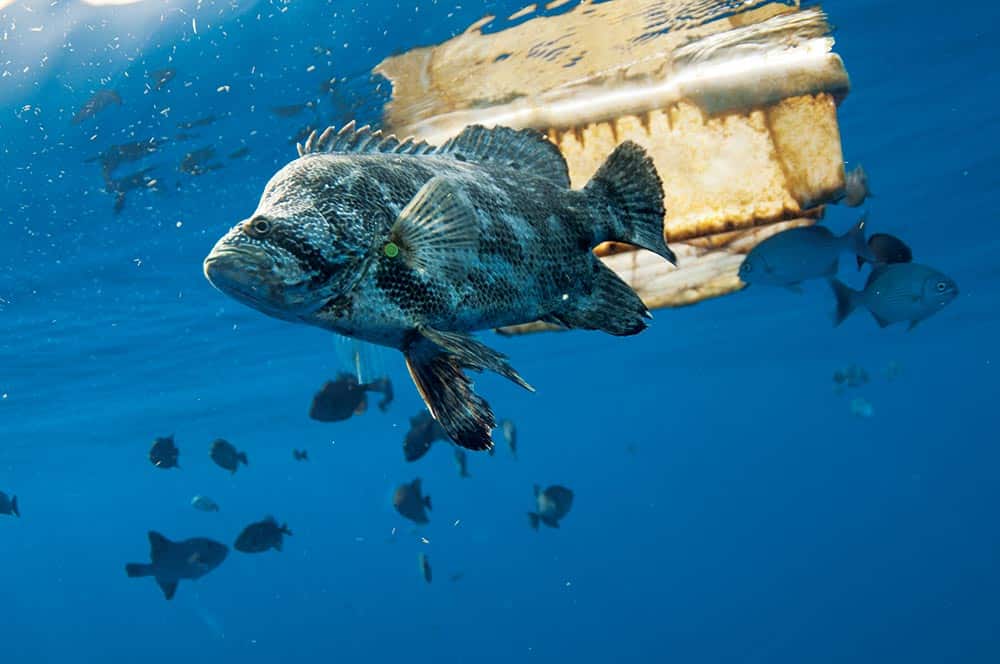
Where Can You Find a Tripletail Fish?
Tripletail fish is a pelagic fish that lives in warm and temperate waters around the world. It prefers coastal areas with structures such as buoys, pilings, floating debris, or seaweed. It often lies on its side near the surface, mimicking a leaf, a piece of driftwood or other floating debris. This is thought to help it avoid predators and ambush prey.
Tripletail are commonly found in the Gulf of Mexico, along the southeastern coast of the United States, and in various other tropical and subtropical regions of the world. This preference for warm waters, and floating structure, means that you can often find them around buoys, channel markers, and weed lines, or other floating debris.

It is this affinity that makes tripletail a relatively easy target for anglers. It is merely a matter of locating structures or “weed lines” holding tripletail, placing appropriate bait near the waiting fish, and then the action begins. The biggest obstacle to landing these fish is trying to pull them away from pilings or other obstacles before they wrap or tangle the line and break-off. Other Factors such as water temperature, salinity, and the presence of baitfish will also play a significant role in finding tripletail.
Some of the Best Places to Find Tripletail Fish
Gulf of Mexico: This is one of the most popular and productive areas for tripletail fishing. You can find them near shore in 20 to 30 feet of water, especially during the late spring and early summer months. They also migrate offshore in winter and inhabit oil rigs and sargassum weed patches.
Off the coast of North Carolina: This is another hotspot for tripletail fishing. You can find them near the mouth of rivers, inlets, and bays, as well as around navigation markers, moored boats, and reefs. They are more abundant during the autumn months when they move back to warmer waters.
Waters near Florida: This is a great place to catch tripletail fish year-round. You can find them in both the Atlantic and Gulf coasts, as well as in the Keys. They are often found near crab-trap buoys, sargassum weed, and pilings. They can also be caught inshore and offshore.
Along the Texas coast: Tripletail are most abundant in the Gulf of Mexico in the nearshore waters off of the Sabine Lake area. The Gulf off Galveston and Matagorda are second and third highest producers. In Texas bays, however, West Matagorda Bay is where most tripletail are usually caught by recreational anglers and in TPWD gill nets.
How Can You Catch a Tripletail Fish?
Tripletail fish is known for its strong fights and acrobatic jumps. It can also be very elusive and wary of anglers. To catch a tripletail fish, you need to use light to medium tackle with a spinning or baitcasting reel. You can use live or artificial baits such as shrimp, crabs, minnows, or jigs. You can also use flies if you are into fly fishing.
The key to catching a tripletail fish is to locate its hiding spots and cast your bait near them. You can use polarized sunglasses to spot the fish near the surface. You can also look for signs of floating debris or vegetation that might attract the fish.
Once you hook a tripletail fish, be prepared for a tough fight. The fish will try to escape by diving deep or running sideways. You need to keep your line tight and your rod tip high to prevent the fish from breaking free or tangling your line in the structure.
Seasonal Behavior of Tripletail
Understanding the seasonal behavior of Tripletail is essential for fishing success. The best time of year to catch tripletail fish is during the warmer months of late spring and early summer. Tripletail migrate to shallower waters, providing anglers with increased opportunities for sightings and catches.
This is when they are most active and can be found in large numbers near shore. The water temperature during this time of year is also ideal for tripletail, as they prefer warm waters. In colder seasons, they may move to deeper waters or migrate to warmer regions, requiring a strategic shift in fishing tactics
However, tripletail fish can be caught throughout the year depending on the weather conditions and where they are located. So if you’re unable to fish during the late spring and early summer months, don’t worry – you can still have success if you know where to look and what conditions to fish in.
Like any gamefish, anglers should adapt their approach based on the seasons, using different baits and techniques to have success catching Tripletail during their various behavioral phases.
7 Tips for Targeting TripleTail Fish
Mastering effective Tripletail fishing techniques requires a combination of patience, skill, and adaptability. The following tips and tactics are outlines proven methods for increasing your chances of a successful catch:
1. Spotting Tripletail – Look for floating structures, debris, or buoys where Tripletail may seek shelter. Scan the water’s surface for the telltale signs of Tripletail, such as their distinctive dorsal fins.
2. Approaching Stealthily – Tripletail can be easily spooked, so approach your target area quietly and avoid making unnecessary noise. Use a trolling motor or paddle instead of a loud outboard engine when maneuvering around fishing grounds.
3. Accurate Casting – Cast your bait or lure with precision, placing it close to the Tripletail’s suspected location. Tripletail are ambush predators, so presenting your bait in their striking range is crucial.
4. Practice Patience – Tripletail may take their time inspecting the bait before striking, so exercise patience during the waiting game. Be attentive to subtle movements or vibrations on the line that indicate a Tripletail has picked up your bait.
5. Delayed Hookset – When you feel a bite, resist the urge to set the hook immediately. Wait until you feel the weight of the fish before executing a controlled hookset.
6. Maintain Steady Pressure – Once the hook is set, maintain tension on the line to prevent the fish from shaking the hook. Let the fish run if it wants, but don’t allow any slack in your line during the fight.
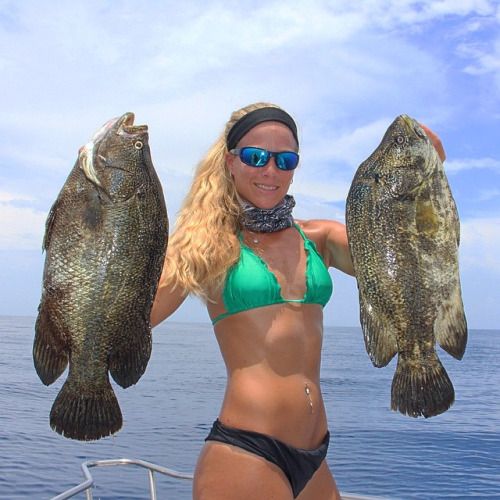
7. Landing Tripletail – Use a landing net or fish gripper to secure the Tripletail, avoiding direct contact. If you want fish for dinner, keep what you can use, then practice catch-and-release with the rest, for the conservation of these unique fish.
Gear for Catching Tripletail Fish
Equipping yourself with the right gear is essential when targeting Tripletail. Given their preference for structure, anglers often use medium to heavy spinning or baitcasting tackle to navigate around buoys and other obstacles. Braided line is preferred for its strength and sensitivity, allowing anglers to detect subtle bites and react quickly.
When it comes to bait and lures, live shrimp, crabs, and small baitfish are your best choices. Tripletail are opportunistic feeders, so presenting a tempting and lifelike bait is hard for them to resist. Artificial lures such as soft plastics and topwater plugs can also attract the attention of Tripletail.
To fish for tripletail fish, you need to have the following gear:
- A lightweight and fast-action rod that can cast far and handle strong fights. A 7- to 9-foot rod is a good choice.
- A reliable and smooth reel that can handle the runs and jumps of tripletail fish. Spinning or baitcasting reel with a good drag system and enough line capacity.
- Line that is suitable for the water conditions and the type of bait or lure you are using. You can use monofilament, fluorocarbon, or braided line, depending on your preference and the clarity of the water.
- Leader that is strong enough to withstand the teeth and abrasion of tripletail fish. You can use a 20 to 30 lb monofilament or fluorocarbon leader.
- A hook that is sharp and sturdy enough to penetrate and hold the tripletail fish. You can use a circle hook, a J hook, or a weedless hook, depending on the type of bait or lure you are using.
- Bait or lure that is attractive and realistic enough to entice the tripletail fish. You can use live or artificial baits such as shrimp, crabs, minnows, jigs, swim baits, shrimp flies, or crab flies.
Baits for Targeting Tripletail Fish
The best bait to use for tripletail fish depends on the situation and the preference of the fish. However, some of the most common and effective baits are:
Natural Baits
Live shrimp: Live shrimp are a natural and irresistible food for tripletail fish. They can be hooked through the tail or the head and cast near the structure where the fish are hiding. Live shrimp are also easy to find and store on the boat.
Squid: Squid are another good option for tripletail fish. They can be cut into small pieces and hooked on a small circle hook. Squid are durable and can withstand multiple casts. They also have a strong scent that can attract the fish.
Minnows: Minnows are small fish that can be used as live or dead bait for tripletail fish. They can be hooked through the lips or the back and cast near the surface where the fish are lying. Minnows are also versatile and can be used with floats, jigs, or flies.
Artificial Lures
Artificial lures can also work well for tripletail fish, especially when they are not interested in natural baits. Some of the best artificial lures for tripletail fish are
Gulp Peeler Crabs: These are soft plastic lures that mimic the shape and movement of crabs, which are a favorite food for tripletail fish. They can be rigged on a jig head or a weedless hook and bounced along the bottom or near the structure.
Swim Baits: These are soft plastic lures that resemble small fish, such as mullet or shad. They have a paddle tail that creates vibration and action in the water. They can be rigged on a jig head or a swimbait hook and retrieved slowly or twitched near the surface.
Shrimp Flies: These are flies that imitate shrimp, which are another natural food for tripletail fish. They have a weighted head and a fluffy body that create a realistic profile and movement in the water. They can be cast with a fly rod or a spinning rod and presented near the structure or on the surface.
Crab Flies: These are flies that imitate crabs, which are also a natural food for tripletail fish. They have a hard shell and legs that create a realistic profile and movement in the water. They can be cast with a fly rod or a spinning rod and presented near the bottom or near the structure.
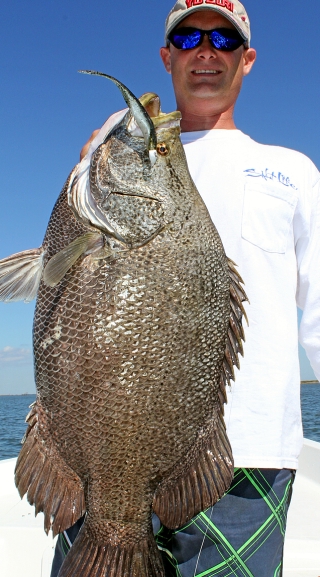
Most Common Challenges in Tripletail Fishing
Tripletail fishing, while exhilarating, comes with its share of challenges. Anglers may encounter difficulties such as:
1. Spooky Behavior – Tripletail can be easily scared away, requiring anglers to approach cautiously and quietly.
2. Changing Conditions – Weather and water conditions can impact Tripletail behavior, necessitating adaptability in fishing strategies.
3. Selectivity in Prey – Tripletail can be choosy about their prey, making it essential for anglers to experiment with different baits.
4. Navigational Hazards – Fishing around buoys and structures poses navigational challenges, demanding careful boat handling.
5. Hooking and Landing – Tripletail are known for their strong fight, making it crucial for anglers to master the art of hooking and landing them before they can cut you off on the structure.
Overcoming these challenges adds to the excitement of Tripletail fishing, requiring anglers to continually refine their skills and adapt to changing conditions.
Conservation of Tripletail
As responsible anglers, it’s imperative to prioritize the conservation of Tripletail populations. Sustainable fishing practices, including catch-and-release when appropriate, contribute to the preservation of these unique fish for future generations.
To maintain healthy Tripletail populations, it’s crucial to adhere to fishing regulations. Anglers should familiarize themselves with local regulations and stay informed about any changes to ensure compliance and promote responsible fishing.

Anglers can play a role in conservation by the following:
- Adhering to fishing regulations and size limits.
- Reporting illegal or unethical fishing practices.
- Participating in conservation initiatives and research projects.
- Practicing Catch-and-Release when possible.
By maintaining a balance between the thrill of the catch and environmental stewardship, anglers ensure that Tripletail fishing remains a sustainable and enjoyable activity for generations to come.
Tips for Catch-and-Release of Tripletail
As with any gamefish population, catch-and-release practices are essential for the sustainability of Tripletail populations. Here are some tips for ensuring the well-being of the fish after release:
– Use barbless hooks to minimize injury.
– Handle Tripletail with wet hands to protect their slime coat.
– Release the fish as quickly as possible to reduce stress.
– Allow the fish to revive by holding it in the water until it swims away under its own power.
By adopting these practices, anglers contribute to the conservation of Tripletail and promote ethical fishing.
How Can You Cook a Tripletail Fish?
Tripletail fish is not only fun to catch, but also delicious to eat. It has firm, white, flaky meat that tastes mild and sweet similar. It can be cooked in various ways such as frying, baking, grilling, or broiling.
For those fortunate enough to land a Tripletail, the culinary possibilities are enticing. Here are some cooking tips to make the most of your Tripletail catch:
- Grilling: Tripletail’s firm texture makes it ideal for grilling. Marinate fillets with your favorite spices and grill to perfection.
- Baking: Create flavorful baked dishes by seasoning Tripletail fillets with herbs, lemon, and olive oil.
- Pan-Seared: Achieve a crispy exterior and tender interior by pan-searing Tripletail fillets in butter or olive oil.
Experimenting with different recipes allows anglers to savor the fruits of their labor and share the joys of Tripletail fishing with friends and family.
Pan-Fried Tripletail
One of the simplest and tastiest ways to cook a tripletail fish is to pan-fry it with butter, garlic, lemon juice, salt, and pepper. You can also add some fresh herbs such as parsley or dill for extra flavor. Here is a quick recipe for pan-fried tripletail fish:

- Rinse the tripletail fillets and pat them dry with paper towels.
- Season them with salt and pepper on both sides.
- Heat some butter in a large skillet over medium-high heat.
- Add some minced garlic and cook for about a minute, stirring occasionally.
- Add the tripletail fillets and cook for about 4 minutes per side, or until golden and flaky.
- Transfer the fillets to a platter and drizzle with lemon juice.
- Garnish with chopped parsley or dill and serve with your favorite side dish.
Tripletail Stuffed with Leek, Mushroom & Spinach
This delicious fish pairs beautifully with the delicate flavors of leek, mushroom and spinach, and it’s all topped with a crunchy Panko and Parmesan mixture.
Ingredients
Parmesan/Panko Topping
- 1/2 c. Panko bread flakes
- 1/4 c. Grated Parmesan
- 1/8 tsp. Freshly ground black pepper
- 1 Tb. Melted butter, unsalted
Fish
- 1 lb. Tripletail fillets, cleaned & patted dry (alt: Flounder, Snapper, Grouper)
- 1 Tb. Unsalted butter
- 1 Tb. Olive oil
- 8+ Cremini or white mushrooms, chopped
- 1 Leek, cleaned & sliced (white part only)
- 2 c. Baby spinach (large stems removed)
- 1/4 tsp. Kosher salt
- 1/8 tsp. Freshly ground black pepper
- 1 Tb. Melted butter, unsalted

Instructions
- Combine Topping ingredients in small bowl; mix to combine then set aside until ready to use.
- Heat oven to 400 degrees, then butter the bottom of a 9X13 baking dish.
- Cut fillets into 4 portions and place in baking dish; sprinkle with a little salt and pepper.
- Heat a non-stick skillet to medium. Add 1 Tb. butter and 1 Tb. olive oil. When warm, add chopped mushrooms and leeks and sprinkle with 1/4 tsp. salt and 1/8 tsp. pepper. Cook until soft (about 5 minutes) and stir frequently. Add spinach and combine the leaves with the warm mixture so they wilt. When the spinach looks soft (about 1 minute), remove from heat.
- Top each fillet with some of the vegetable mixture, then sprinkle each with Panko mixture. Melt the butter, then sprinkle a little over each bundle.
- Bake about 15 minutes (depending on thickness of fillets). Check around the 10-minute mark to ensure the coating is browning, but not burning. The fish will be bubbly, bright white and flaky when cooked. If it’s still opaque, leave it in a bit longer.
Frequently Asked Questions about Tripletail Fish

Are Tripletail good for eating?
Yes, Tripletail is known for its mild, sweet flavor, making it excellent for eating. Many anglers enjoy preparing Tripletail in various ways, including grilling, baking, and pan-searing.
What is the best time to fish for Tripletail?
Tripletail fishing is most productive during warmer months when they migrate to shallower waters. However, the exact timing can vary based on geographical locations and local conditions.
How can I contribute to Tripletail conservation?
Practice catch-and-release when appropriate, adhere to fishing regulations, and participate in conservation initiatives. Reporting illegal fishing activities also helps protect Tripletail populations
What are common mistakes to avoid in Tripletail fishing?
Avoid making loud noises that can spook Tripletail, use suitable gear, and be patient during the waiting game. Additionally, follow ethical fishing practices to minimize stress on the resource.
Test Your Angling Skill on Tripletail Fish
Tripletail fish is a fascinating and tasty fish that deserves more attention from anglers and cooks alike. Fishing for Tripletail fishing has the added challenge of understanding these unique fish and their habits. From choosing the right gear to learning where to look, and what to look for, when trying to locate tripletail.
They are a very unique fish that present some unique challenges. If you get a chance to toss a bait or lure at one, it’ll be an experience you’ll never forget, and one you’ll want to try again and again.
We don’t know much about tripletail, they are excellent on the dinner table. So, keep what you can use and release the rest to preserve the population for future generations of anglers.
As always, stay safe, enjoy the journey and please try to leave it cleaner than you found it. If you have any comments, questions, ideas or suggestions please leave them in the comment section below and I’ll get back to you asap.
You can follow us on Facebook: Rex The Beach Angler, Instagram: thebeachangler7, Twitter: @AnglerBeach, and YouTube: Man Art Creations.

P.S. – Thanks so much for checking out our blog we really appreciate it. Just so you know, we may receive a commission if you click on some of the links that appear on our site. This helps us keep our content free and up-to-date for everyone. We appreciate your support!
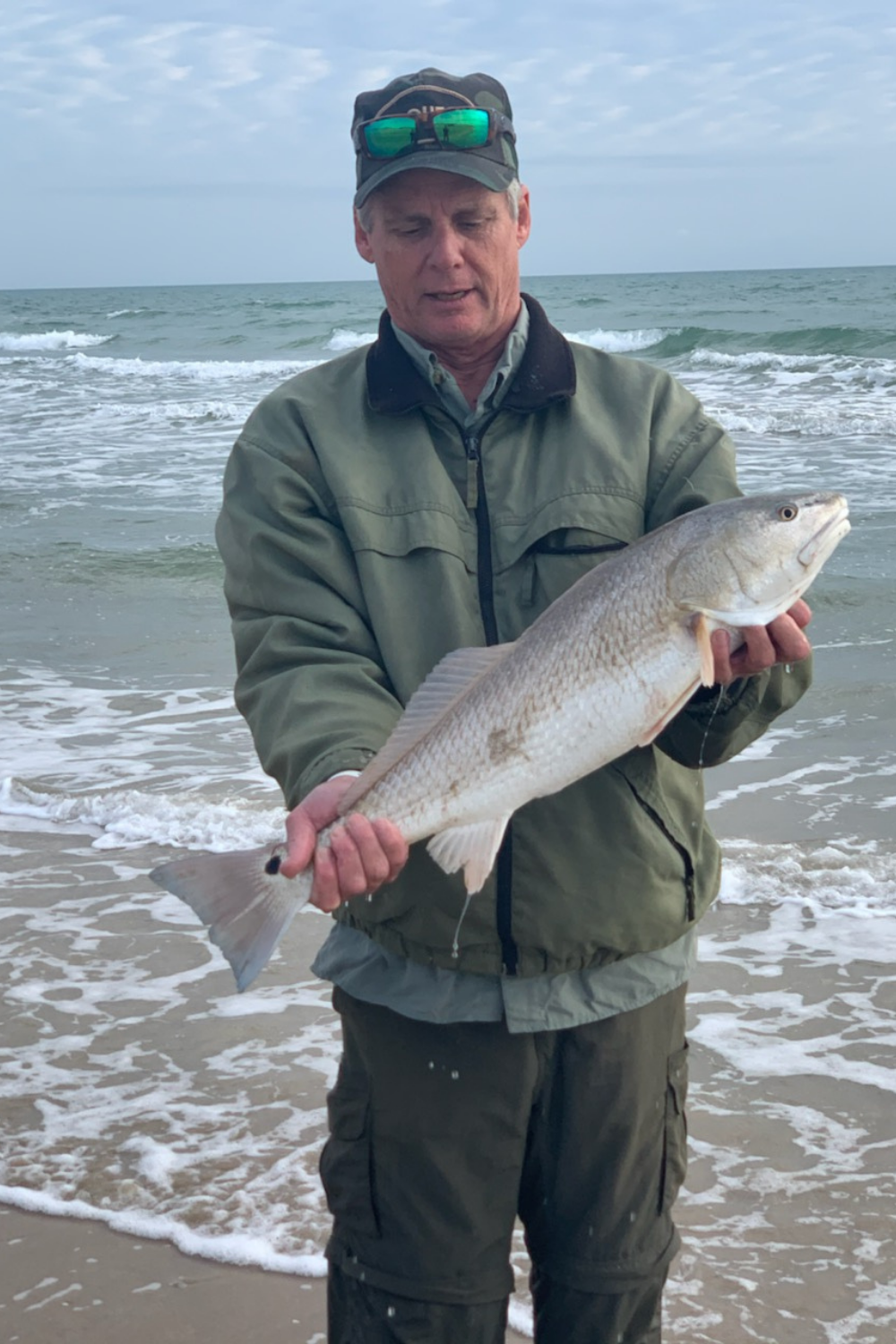
A life long surf fisherman with 50+ years of experience, I am also an avid hunter and outdoorsman. I will be sharing my passion for the outdoors with you so be prepared for hunting, fishing, camping, hiking and more. Along with gear reviews and the latest trends and innovations in the outdoor industry.
